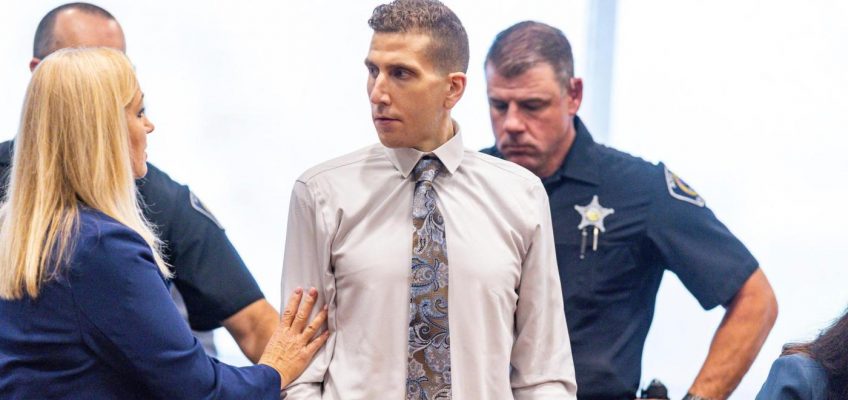By JESSE BEDAYN
BOISE, Idaho (AP) — The lead prosecutor tasked with finding justice for four University of Idaho students killed in a grisly quadruple stabbing more than two years ago laid out his key evidence Wednesday at a court hearing for Bryan Kohberger, who agreed to plead guilty earlier this week to avoid the death penalty.
The evidentiary summary — recited by lead prosecutor Bill Thompson before Kohberger entered his pleas — spun a dramatic tale that included a DNA-laden Q-tip plucked from the garbage in the dead of the night, a getaway car stripped so clean of evidence that it was “essentially disassembled inside” and a fateful early-morning Door Dash order that may have put one of the victims in Kohberger’s path.
These details offered new insights into how the crime unfolded on Nov. 13, 2022, and how investigators ultimately solved the case using surveillance footage, cell phone tracking and DNA matching. But the synopsis leaves hanging key questions that could have been answered at trial — including a motive for the stabbings and why Kohberger picked that house, and those victims, all apparent strangers to him.
The small farming community of Moscow, in the northern Idaho panhandle, had not had a homicide in about five years when Kaylee Goncalves, Ethan Chapin, Xana Kernodle and Madison Mogen were found dead at a rental home near campus.
Kohberger, now 30, had begun a doctoral degree in criminal justice at nearby Washington State University — across the state line from Moscow, Idaho — months before the crimes.
“The defendant has studied crime,” Thompson said, as the victims’ family members dabbed at their tears. “In fact, he did a detailed paper on crime scene processing when he was working on his Ph.D., and he had that knowledge skillset.”
What we learned from the hearing
Kohberger’s cell phone began connecting with cell towers in the area of the crime more than four months before the stabbings, Thompson said, and pinged on those towers 23 times between the hours of 10 p.m. and 4 a.m. in that time period.
A compilation of surveillance videos from neighbors and businesses also placed Kohberger’s vehicle — known to investigators because of a routine traffic stop by police in August — in the area.
On the night of the killings, Kohberger parked behind the house and entered through a sliding door to the kitchen at the back of the house shortly after 4 a.m., Thompson said. He moved to the third floor, where Madison Mogen and Kaylee Goncalves were sleeping.
After killing both of them with a knife, Kohberger left a knife sheath next to Mogen’s body. Both victims’ blood was later found on the sheath, along with DNA from a single male that ultimately helped investigators pinpoint Kohberger as the only suspect.
On the floor below, another student was still awake. Xana Kernodle had ordered Door Dash not long before, and as Kohberger was leaving, he crossed paths with her and killed her with a large knife, Thompson said. He then killed her boyfriend, Ethan Chapin, who was sleeping in Kernodle’s bedroom.
Kohberger left two others in the house alive, including one roommate who was expected to testify at trial that sometime before 4:19 a.m. she saw an intruder there with “bushy eyebrows,” wearing black clothing and a ski mask.
Roughly five minutes later, the car could be seen on the next-door neighbor’s surveillance camera. speeding away so fast “the car almost loses control as it makes the corner,” Thompson said.
What did Kohberger do next?
After Kohberger fled the scene, Thompson said, his cover-up was elaborate.
Prosecutors believe he drove backroads to his apartment in Pullman, Washington, to avoid surveillance cameras on the major roads and didn’t turn his cell phone back on until 4:48 a.m. By 5:26 a.m., he was back in Pullman, Thompson said.
Later, Kohberger changed his car registration from Pennsylvania to Washington State — significant for investigators who were combing through surveillance camera footage because Pennsylvania law doesn’t require a front license plate, making it harder to identify the vehicle.
And by the time investigators did catch up with him weeks later, his apartment and office in nearby Pullman were scrubbed clean.
“Spartan would be a kind characterization. There was nothing there, nothing of evidentiary value was found,” Thompson said of Kohberger’s apartment.
The car, too, “had been essentially disassembled inside,” he added. “It was spotless. The defendant’s car had been meticulously cleaned inside.”
The Q-tip that broke the case
Investigators had honed in on Kohberger, but they needed to prove he was their suspect.
With the DNA of a single mystery male on the knife sheath, they worked with the FBI and the local sanitation department to secretly retrieve garbage from the Pennsylvania home of Kohberger’s parents, seeking a DNA match to their suspect.
“They conducted what’s called a trash pull during the nighttime hours,” Thompson said, and “took trash that had been set out on the street for collection” and sent it to Idaho’s forensics lab.
The pile of garbage yielded investigative gold: A Q-tip that contained DNA identified “as coming from the father of the person whose DNA was found on the knife sheath that was found by Madison Mogen’s body on the bed,” he said.
With that, Kohberger was arrested at his parents’ home in Pennsylvania, where he had gone for the holidays, and ultimately was extradited to Idaho for prosecution.
The mysteries that remain
Even while prosecutors detailed that night, a key question remains: Why did Kohberger target that house and those victims? Did he know them? And what was his motive?
“We do not have evidence that the defendant had direct contact with 1122 or with residents in 1122, but we can put his phone in the area on those times,” Thompson said, referring to the house number where the murders took place.
Some of that evidence may have come out at trial, and may yet be contained in documents related to the case that have been sealed by the court until after a July 23 sentencing hearing. A gag order in place for all attorneys in the case is still in effect as well.
Those documents include witness lists, a list of exhibits, an analysis of the evidence, requests for additional discovery, filings about mitigating factors and various unsuccessful defense motions that sought to introduce alternative suspects, among other things.
The families of the victims are split over the plea deal
With the case solved, families remain divided over its resolution.
The deal stipulates that Kohberger will be spared execution in exchange for four consecutive life sentences. He also waived his right to appeal and to challenge the sentence.
Chapin’s and Mogen’s families support the deal.
Michael Madsen, ‘Reservoir Dogs’ and ‘Kill Bill’ star, dies
Denny’s and Waffle House remove egg surcharges as prices fall
Average long-term US mortgage rate falls to 6.67%, the lowest level since early April
For Sean ‘Diddy’ Combs, could a lesser conviction mean a greater public rehabilitation?
A volunteer finds the Holy Grail of abolitionist-era Baptist documents in Massachusetts
“We now embark on a new path. We embark on a path of hope and healing,” Mogen’s family said in a statement.
The family of Kaylee Goncalves publicly denounced the plea deal ahead of Wednesday’s hearing and her father refused to attend the proceedings.
Goncalves 18-year-old sister, Aubrie Goncalves, said in a Facebook post that “Bryan Kohberger facing a life in prison means he would still get to speak, form relationships, and engage with the world.”
“Meanwhile, our loved ones have been silenced forever,” she wrote.




